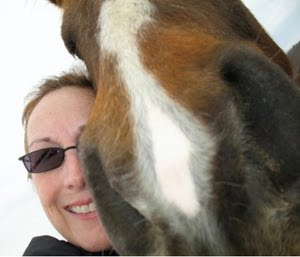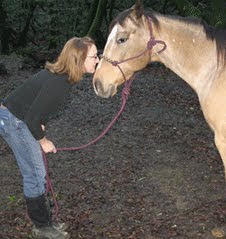

We’re smack dab in the middle of Cowgirl Yoga season – a great time to share my next interview. Michelle Bushneff is a true horse girl at heart; she has a passion that has blossomed in many wonderful directions. She’s also a yogini who attended one of our first Cowgirl Yoga retreats in 2008. She started practicing yoga in her early 40s, around the same time she started working with horses and founded an online community that encourages young girls to nurture their love for horses through reading, writing, and other meaningful activities. She doesn’t have a horse of her own (yet), but spends as much time as possible around horses by taking riding lessons, volunteering, and trail riding.
1. Give us a snapshot of Michelle, girl with the horse bug: when did it start, how has it evolved?
It probably started at birth – I’ve always been animal crazy – but blossomed in the preteen/young teen years like it does (according to my research) for more than 50% of girls. I didn’t have access to horses, but would spend hours and hours reading horse books, looking at pictures, drawing, and dreaming of horses. I came back to horses in my early 40s and took an unusual path from book learning to ground work, riding and training with horses. During this time I also founded Girls Horse Club.
2. Share your vision for Girls Horse Club.
The seed for GHC started with my own love for animals, but the real inspiration came from Marce, the daughter of a friend. Even before I started riding and training as an adult, I saw how horses inspired her to learn and grow. While many teen girls were caught up in shopping and boys, she was learning to take public transportation to a stable, teaching herself HTML to participate in online horse simulation, and reading about genetics so she could understand how horses get their coloring – all motivated by her passion for horses.
Long story short, in 2001, after a long history developing “edutainment” content in emerging media/technology markets, GHC was born with the mission to entertain, educate, empower, and inspire girls through their love for horses. I wanted it to be accessible to everyone from girls who only dreamed of horses to those who were lucky enough to attend horse camps, take lessons, or have a horse of their own, so a “virtual barn” was the perfect place. I also developed product concepts and prototypes for collectible horse models, electronic games and books. None of those have come to life (yet), but the site remains a cornerstone of the vision. GHC has gone through lots of evolution over the years (and a bit of drama too), but the vision has never wavered.
These days GHC is a total labor of love so activity ebbs and flows depending on what’s going on in my family and/or professional life at any given moment. This summer a couple of longtime contributors are leading activities that challenge GHCers to get out in the real horse world, and take steps to realize their horse dreams. How cool is that?
I could go on and on about the amazing girls who have contributed to GHC over the years, but all have proven that horses bring out the best in young (and not-so-young) girls. In fact, the girl who was the original inspiration is now a not-so-young girl in medical school, she’s still completely horse crazy, she’s a very accomplished rider/trainer, and we still keep in touch, thanks to Facebook.
3. You’re a yogini. Your thoughts on the connection between yoga and riding?
I see connections on so many levels. There are physical parallels, like building overall strength and balance that’s centered in your core while tuning into your body and the signals it’s sending to you (yoga) and the horse (riding). There are mental/emotional parallels – working through fear (“I’m going to fall off the horse if I try to canter” or “I’m going to break in half if I try a backbend”) and challenge by learning to breathe and focus. And I love that there’s an endless amount of knowledge to be gained and challenges to overcome when practicing yoga and working with horses.
4. Tell us about your equine therapy volunteer program. Is this your first?
I first learned about equine therapies when my niece, who has cerebral palsy that confines her to a wheelchair, starting riding for hippotherapy. Turns out when you’re sitting on a horse, the movement is similar to a human’s walk and that stimulates neurological function in the rider. I attended her lessons a few times as a side walker, and was amazed at how it helped her posture and control. Plus it was much more fun than other types of physical therapies.
A few years later, I met some people through GHC who founded a riding program for kids and adults with physical, mental, and emotional disabilities. I was so inspired by their stories of healing I signed on as a volunteer. I worked there for four years, then circumstances changed that led me to a different program where I’m currently working as a volunteer. I’ve also taken some courses to learn more about therapeutic riding and hope to continue my education.
5. What was your most inspirational moment working in a therapeutic riding program?
Years ago, I worked with a 94-year old woman who had suffered a stroke that limited her mobility. She walked hunched over with a cane for support, but she managed to drive herself (yes, drive herself) 20 miles along a major freeway to her weekly lessons. When she climbed on her horse (with assistance), she sat up tall and defied her limitations. Because her mind was as vivid as it was when she first started riding as a young girl, she expected her body to have the same memories, and she would get frustrated with herself.
But in spite of her age and physical limitations, she had a dream – she wanted to ride again, on her own (without the usual side walkers) at the running walk on a Tennessee Walker who was the first horse bred, born and trained into this riding program. Not only did she realize her dream, but she did it on camera with dozens of volunteers and a film crew watching. It was a gift to witness. You can see it yourself on this video. She comes in just after the 8 minute mark – have a tissue ready. [Editor’s note: just add that to the long list of ways that horses have made me cry…in a good way, of course!]
If you’re interested in volunteering or learning more about equine-assisted therapies, there are several organizations that offer training/accreditation and list local programs – NARHA, EAGALA, and EGE are a few.